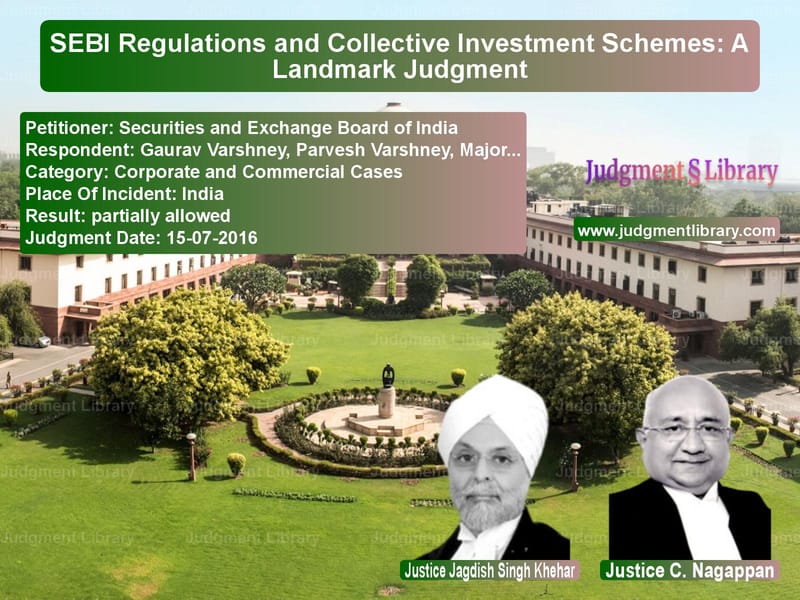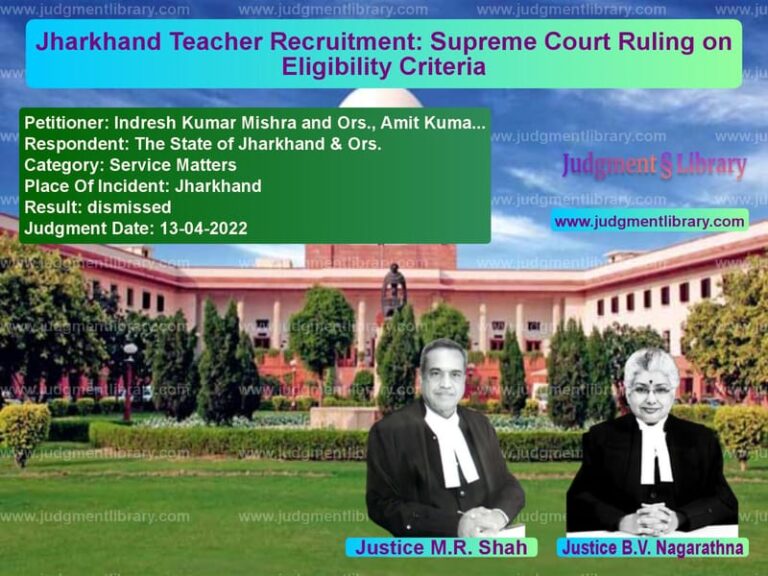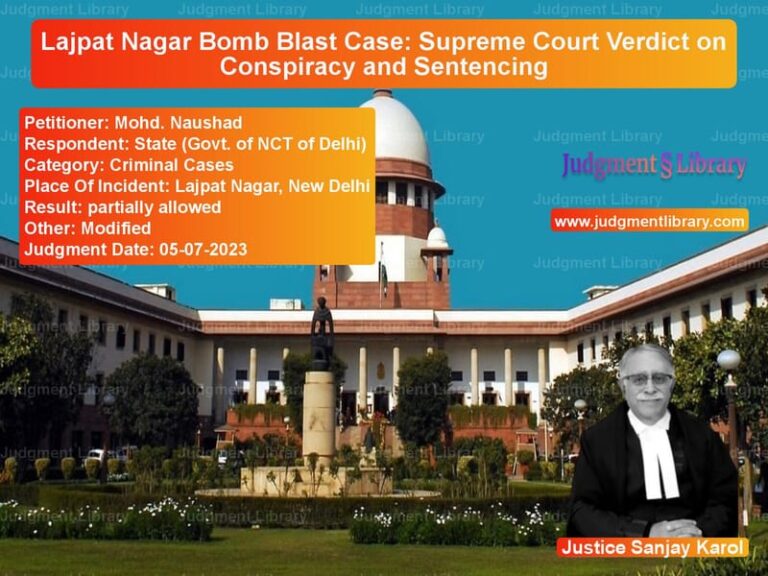SEBI Regulations and Collective Investment Schemes: A Landmark Judgment
The Supreme Court of India, in the case of Securities and Exchange Board of India (SEBI) vs. Gaurav Varshney & Ors., has delivered a crucial ruling on the interpretation and enforcement of Section 12(1B) of the SEBI Act, 1992. This landmark judgment provides clarity on the legality of collective investment schemes (CIS) and the obligations of individuals and entities operating such schemes.
The ruling arose from a series of appeals filed by SEBI against various individuals and entities accused of violating SEBI regulations by initiating and operating CIS without obtaining mandatory registration. The key legal question before the Court was whether these individuals could be held liable for commencing investment schemes after the amendment to the SEBI Act in 1995 without regulatory approval.
Background of the Case
The Securities and Exchange Board of India (SEBI) is the regulatory authority governing capital markets and investment schemes in India. To regulate collective investment schemes, Section 12(1B) was introduced in the SEBI Act on January 25, 1995. This provision prohibits any person or entity from sponsoring or operating a collective investment scheme without first obtaining registration from SEBI.
Several entities and individuals, including the respondents in this case, initiated collective investment schemes post-1995 without obtaining SEBI registration. SEBI, through various circulars and press releases, reiterated the mandatory registration requirement and issued notices to defaulting entities. Despite these warnings, some continued operating unregistered CIS.
SEBI initiated criminal proceedings against the respondents, alleging violations of Section 12(1B). The accused contested the charges, arguing that the SEBI (Collective Investment Schemes) Regulations, 1999, came into effect after their operations began and should not apply retroactively. The lower courts ruled in favor of the respondents, prompting SEBI to appeal before the Supreme Court.
Key Legal Issues Considered
- Did Section 12(1B) of the SEBI Act prohibit new collective investment schemes without registration after January 25, 1995?
- Did SEBI provide adequate notice and opportunity for compliance before initiating legal proceedings?
- Could individuals be held liable for CIS operations initiated before the 1999 regulations were enacted?
- Were the lower courts justified in quashing proceedings against certain respondents?
Arguments from Both Sides
Petitioner’s (SEBI) Arguments
- “The language of Section 12(1B) clearly prohibits any person from sponsoring or operating a CIS without obtaining SEBI registration.”
- “The provision came into effect on January 25, 1995, and was binding from that date.”
- “Respondents continued to operate investment schemes despite multiple warnings and notices from SEBI.”
- “The 1999 regulations merely provided a framework for enforcement; the prohibition had already existed.”
Respondents’ Defense
- “The prohibition under Section 12(1B) was not enforceable until the SEBI (CIS) Regulations, 1999, were notified.”
- “SEBI did not provide a reasonable timeframe for compliance before initiating criminal proceedings.”
- “Some respondents had resigned from their companies before the regulations were enforced and cannot be held liable.”
- “The lower courts correctly ruled that retrospective application of penalties was unconstitutional.”
Supreme Court’s Judgment
The Supreme Court analyzed the statutory framework and regulatory notifications issued by SEBI between 1995 and 1999. It ruled:
- “The intent of Section 12(1B) was to impose an immediate prohibition on new collective investment schemes from January 25, 1995.”
- “The 1999 regulations provided clarity on implementation but did not override the prohibition already in place.”
- “Entities commencing CIS after January 25, 1995, without registration were in clear violation of the SEBI Act.”
- “However, in cases where respondents had ceased operations or resigned before the 1999 regulations, criminal liability does not arise.”
Detailed Analysis of the Judgment
The Supreme Court provided an in-depth examination of regulatory intent and statutory interpretation:
- It reaffirmed SEBI’s authority to regulate investment schemes to protect investors from fraudulent operations.
- It clarified that regulatory restrictions can take effect even before detailed implementation guidelines are issued.
- It emphasized that liability must be assessed based on operational timelines—those actively involved post-1999 were fully liable.
- It recognized that criminal proceedings should not be pursued against individuals who had exited before regulatory enforcement began.
The Court further observed:
“Investment schemes that operate outside the regulatory framework pose a significant risk to investors and market stability. The enforcement of Section 12(1B) from January 25, 1995, was intended to ensure that such schemes do not proliferate without oversight.”
Implications of the Judgment
This ruling has far-reaching consequences:
- It strengthens SEBI’s enforcement capabilities by affirming that regulations can be binding even before specific rules are enacted.
- It clarifies the timeline of compliance for collective investment schemes, preventing misinterpretation of regulatory requirements.
- It provides legal precedent for holding promoters and directors accountable if they continue unregistered CIS operations post-1995.
- It ensures that individuals who had resigned or ceased operations before the 1999 regulations are not unfairly prosecuted.
Conclusion
The Supreme Court’s decision in this case reinforces SEBI’s regulatory authority and establishes critical principles for compliance with financial regulations. By upholding the validity of Section 12(1B) from 1995, the Court has ensured stricter oversight of collective investment schemes and provided clarity on the obligations of those operating such schemes. The ruling also serves as a warning to financial entities that regulatory compliance is mandatory and cannot be bypassed under technical pretexts.
Don’t miss out on the full details! Download the complete judgment in PDF format below and gain valuable insights instantly!
Download Judgment: Securities and Excha vs Gaurav Varshney, Par Supreme Court of India Judgment Dated 15-07-2016-1741873246718.pdf
Direct Downlaod Judgment: Direct downlaod this Judgment
See all petitions in Corporate Governance
See all petitions in Company Law
See all petitions in Bankruptcy and Insolvency
See all petitions in Judgment by Jagdish Singh Khehar
See all petitions in Judgment by C. Nagappan
See all petitions in partially allowed
See all petitions in supreme court of India judgments July 2016
See all petitions in 2016 judgments
See all posts in Corporate and Commercial Cases Category
See all allowed petitions in Corporate and Commercial Cases Category
See all Dismissed petitions in Corporate and Commercial Cases Category
See all partially allowed petitions in Corporate and Commercial Cases Category







